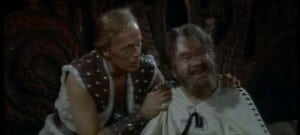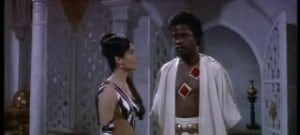The Greatest Viking Adventure of Them All!
Surprisingly, we aren’t talking about the Kirk Douglas and Tony Curtis epic The Vikings. Though 1964’s The Long Ships was directed by Jack Cardiff, the cinematographer of The Vikings, the similarities do not go much farther.
Filmed at what one might saw was the end of the classic epic picture which was so prevalent in the 1950s, The Long Ships has a rather odd pairing of Richard Widmark and Sidney Poitier in the lead roles, as a delinquent (yet playful) son of a Viking lord, and a Moorish Ruler, respectively .
Perhaps given the success of the earlier Viking film, the overall feeling here is one where the tongue is firmly in cheek. Though some have likened the film to an odd kind of “The Vikings Meet Monty Python,” that is clearly an overstatement. Although the plot is severely weak (and lighthearted) and there are several continuity and factual error, the film is still quite enjoyable with its roughly two hour running time. With the exception of Poitier, everyone seems to be in on the lighthearted feel. Poitier however, seems to be attempting his best Olivier impression.
 Now to that bogus plot. Widmark (playing Rolfe) has heard of the “Mother of All Voices,” a solid gold bell made by monks, but no one seems to know if it is just a fairy tale or reality. Poitier for one has dedicated his life to finding it. After escaping from the clutches of the evil Aly Mansuh (Poitier), Rolfe swims back to Scandia from the ‘Moorish’ lands. After a brief reconciliation with his family, he steals a ship built for his father’s King. Said King Harald (Clfford Evans) follows in hot pursuit.
Now to that bogus plot. Widmark (playing Rolfe) has heard of the “Mother of All Voices,” a solid gold bell made by monks, but no one seems to know if it is just a fairy tale or reality. Poitier for one has dedicated his life to finding it. After escaping from the clutches of the evil Aly Mansuh (Poitier), Rolfe swims back to Scandia from the ‘Moorish’ lands. After a brief reconciliation with his family, he steals a ship built for his father’s King. Said King Harald (Clfford Evans) follows in hot pursuit.
 Of course after a few comings and goings he and his crew is again captured by Mansuh, who again works him for information about this wondrous bell. Now, however, Mansuh reveals what might be the star of the film, the gruesome torture device “The Mare of Steel,” where the tortured slides down a 12 foot long blade face down. Not sure if wondrous devise is part of the book on which the film is based, but it definitely has a wow factor- though truth be told it is more of a death devise as surely no one survives such a thing.
Of course after a few comings and goings he and his crew is again captured by Mansuh, who again works him for information about this wondrous bell. Now, however, Mansuh reveals what might be the star of the film, the gruesome torture device “The Mare of Steel,” where the tortured slides down a 12 foot long blade face down. Not sure if wondrous devise is part of the book on which the film is based, but it definitely has a wow factor- though truth be told it is more of a death devise as surely no one survives such a thing.
Yet again, the Vikings manage to escape, and again they are caught. But before in what definitely borders on the Pythonesque is a scene where the Viking encounter Poitier’s harem. The bedlam between the Vikings, the twelve or so ladies of the harem, and their male minder, is only slightly above buffoonery. When recaptured again they are made an offer by Mansuh’s wife; find the bell and have your freedom.
 In a nice (and presumably intentional) touch that most will likely not notice is the fact that here Poitier’s wife is in fact apparently a Caucasian woman, in a rare early instance of a mixed marriage on screen.
In a nice (and presumably intentional) touch that most will likely not notice is the fact that here Poitier’s wife is in fact apparently a Caucasian woman, in a rare early instance of a mixed marriage on screen.
At the end of the day of course the bell is found encased in a stone bell tower. After almost no effort whatsoever, the bell is extracted from its home and shipped on a raft back to the Islamic Kingdom. Right on cue, King Harald with his Vikings appear and retake the bell after it rolls over on the hapless Poitier, killing him in the process.
Now mind you there is nary a mark on the bell and the raft is barely large enough for it to sit on, but never mind that. It is all part of the suspension of logic that you need for most Irwin Allen films- among which this is.
 Beyond the plot, the acting is among the strengths of the picture. Especially Widmark who though classically out of his element, understands perfectly the role he turned down several times before accepting. That said, he in only slightly less out of place than poor Sidney Poitier, who tries his best to be the nasty bad guy, but his James Brown bouffant doesn’t help him at all.
Beyond the plot, the acting is among the strengths of the picture. Especially Widmark who though classically out of his element, understands perfectly the role he turned down several times before accepting. That said, he in only slightly less out of place than poor Sidney Poitier, who tries his best to be the nasty bad guy, but his James Brown bouffant doesn’t help him at all.
Though Cardiff is rightfully known as one of the great cinematographers of all time, this outing is merely average. Though taking much from the earlier film The Vikings, the great visual feel of the earlier film is not among them.
Perhaps the most egregious shortfall of The Long Ships is the constant storms which all seem equally poorly shot with some incredibly shoddy special effects. Even the partially camp atmosphere of the film justifies the constant tight shots of the long ship in the same position only to be hit by a bucket of water.
 There’s a storm scene late in the picture where the ship lists precariously, exposing the oars down the port side. But every oar is in precisely the same position as every other, reflecting a serious flaw in the model. In a cost saving move, several of the same shots are used interchangeably during multiple storms. Even by 1964 standards, better should be expected.
There’s a storm scene late in the picture where the ship lists precariously, exposing the oars down the port side. But every oar is in precisely the same position as every other, reflecting a serious flaw in the model. In a cost saving move, several of the same shots are used interchangeably during multiple storms. Even by 1964 standards, better should be expected.
All said though, The Long Ships is a lot of fun. Everyone seems to be in on the joke for the most part. The film is fun and quick paced and one shouldn’t focus overly long on its shortcomings (as I have). The Long Ships is great fun as long as you don’t take it other than it was intended: a nice romp full of adventure.
Suspend a bit of belief and you’ll really enjoy this one. If you want serious, go yank out your “Ben Hur.”
 Could I interest you in an expedition to find one of the three Saxon crowns?
Could I interest you in an expedition to find one of the three Saxon crowns?
